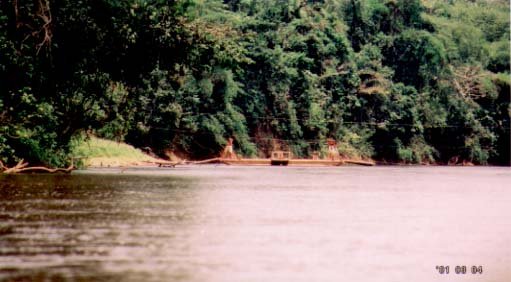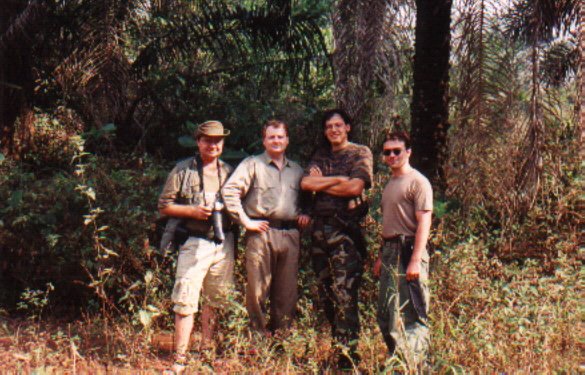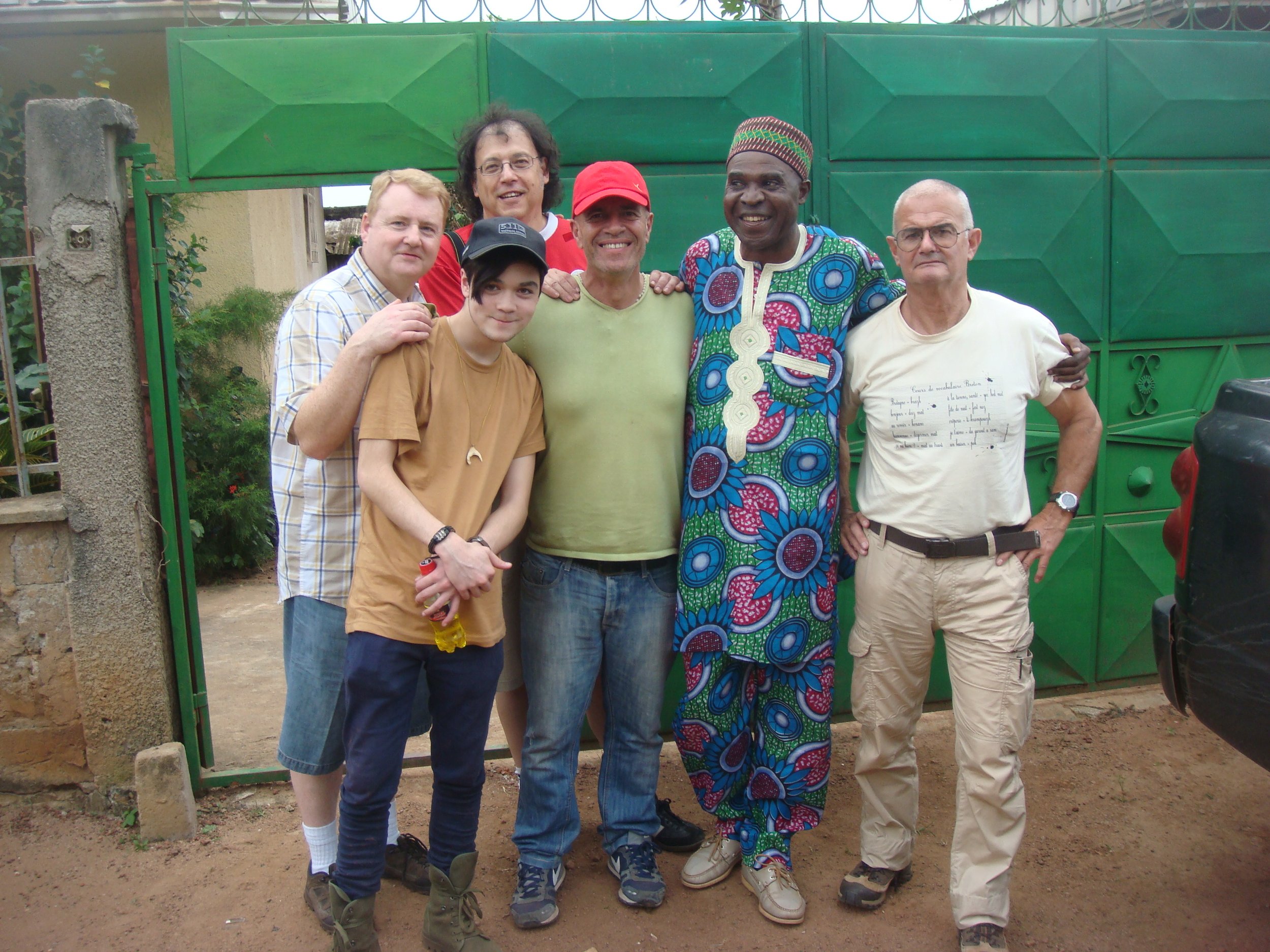
Mokele Mbembe
A long neck, bulbous body and strong short legs…
Mokele Mbembe
While it is understood that the Likouala-aux-Herbes River and Lake Tele are well known as potential habitats for the creature know as Mokele-mbembe, there are believed to be other locales in which animals bearing a close resemblance to a sauropod may be found. These include Gabon, Equatorial Guinea, Central African Republic and Cameroon.
In the past the Congo had been the prime target for Mokele-mbembe investigators such as Dr. Roy P. Mackal and James Powell, Herman and Kia Regusters, Dr. Bill Gibbons and his two operation Congo teams, and Adam Davies. Because of the unstable situation in the Congo, there was no possibility for a team of researchers to be able to safely find it’s way to the Likouala and Lake Tele regions, so the safer confines of Cameroon seemed ripe for investigation, particularly because so many reports of sightings were filtering through.
In February, 2001, a newly founded organization dubbed Cryptosafari put together a team of investigators and researchers (including BCSCC members) and sent them on a mission to follow up reports emanating from Cameroon of an animal which was not supposed to exist today. Missionaries in southern Cameroon were bringing back reports from pygmies of a large animal with a long neck, bulbous body and strong short legs which was inhabiting rivers and swamps close to pygmy habitations.
The team (left) comprising computer whiz Scott Norman, Congo explorer and Mokele-mbembe investigator Bill Gibbons, writer Robert Mullin and John Kirk, author and president of the BCSCC teamed up with Cameroon researcher Pierre Sima and a team of hand-picked pygmy trackers to search the southern part of the country for clues to what it was that had the pygmies concerned.
After an arduous cross country journey over rutted washboard like roads the team reached a major river in the south of the country where base camp was set up. After spending time in the bush searching for clues to the animal it was decided that this course of action would be time consuming and difficult, so a plan based heavily on navigating little travelled rivers was implemented using a native pirogue, or hollowed out log canoe, equipped with an outboard motor.
In addition to river and swamp searches the team was to find and interview eyewitnesses who had seen any unusual wildlife in the area. While washing up after the first day of searching, Robert Mullin casually mentioned the search to a local Bantu boy who became excited. It transpired that the boy’s father, grandfather and uncle had seen a creature they called Mokele-mbembe. Fortuitously, the boy’s father and uncle showed up on the scene and consented to an interview with the Cryptosafari team. The witnesses described a huge creature with a long neck, massive body and a rather indignant temperament which manifested itself when the beast was disturbed.
Having brought a manual of illustrations (left) of a variety of wildlife from around the globe, the team asked the interviewees to identify the animals they had seen should they be depicted in the manual. By now there was a crowd of individuals from a nearby village completing their evening ablutions by the river. The villagers gathered around to see what was going on, the Cryptosafari team separated the witnesses and asked the villagers to wait as they had some animals they wanted to have identified. As the witnesses thumbed through the pages, they correctly identified african animals, but were completely baffled by pictures of north american animals. The investigators were rather surprised to see that the witnesses completely overlooked the illustration in Dr. Roy P. Mackal’s book which depicts a size comparison between a small sauropod and a pygmy, but said nothing. When the witnesses saw illustrations of brachiosaurs and diplodocuses they became excited and cried out “Mokele-mbembe, Mokele-mbembe.”
The villagers had not seen the manual and when the researchers called over small groups of two or three villagers, they were asked to identify the animal known as Mokele-mbembe. Again, they bypassed Mackal’s illustration and consistently identified the brachiosaur and diplodocus as the Mokele-mbembe. After rigorous questioning and a variety of controlled tests and questions, the witnesses and villagers remained unshaken in their belief that two animals which had been supposedly extinct for 65 million years best depicted the creature they called the Mokele-mbembe.
During their sojourn in southern Cameroon, the investigators spoke to dozens of individuals from pygmy villages who identified the two large dinosaurs as either the Mokele-mbembe in the Lingala language or Le Kela-bembe in the Baka pygmy language.
The most recent sighting prior to the expedition was made in April, 2000 when two security men at a primitive ferry operation in the middle of nowhere fled the river banks when a huge aquatic creature with a long neck made it’s way down stream. The two men were utterly terrified by the size of the creature as it was rainy season and for the neck of the creature to be as high as it was in the swollen river the neck had to be at least four metres long. One witness was so disturbed by the encounter that he fled across the border to the Congo.
Despite traversing segments of three rivers the team was unable to locate the creature, but they did continue to run into many individuals and groups who had had sightings of the mystery animal which was so awesome that crocodiles and hippopotamuses stayed well away from its territory. In all of their time in Cameroon the Cryptosafari crew did not see a single hippo or croc despite being in areas where these animals used to abound. The locals attributed this phenomenon to the presence of the Mokele-mbembe in the vicinity.
In 2012, Bill and Andrew Gibbons and John Kirk returned to Cameroon to join Frenchman Michel Ballot (left) in journeying to the Dja river to explore as far north as the Falls of Nki. Joining them were French explorer Serge Grispoux, driver Henri, and guides Blaise and Noel. The expedition took place in what was ostensibly the dry season, but torrential rains and thunderstorms hampered the investigators. It took two full days upriver to reach a camping spot called Camp Silure (catfish). Fishermen on the river had reported seeing a large animal with a long neck which made a sound like that of a giant frog. The weather was hampering investigations and when a member of the team faced a potential medical issue, it was decided to end the expedition the next day.
At 6.30 a.m. Ballot, Andrew Gibbons and Serge Grispoux, journeyed upriver to view the Falls of Nki before they were to return to camp and then journey back down the river to the World Wildlife Fund compound at Ndongo. Not long after the party journeyed to the falls, Kirk and Bill Gibbons heard a strange bellowing in the middle of the river. There are no animals in the area that could have made a sound like that. Gibbon and Kirk’s view was obscured by a line of trees and brush so they tried to negotiate a strip of land to try and see what was causing the bellowing. As they did so, whatever was making the sounds was drawing ever near and with each of two further bellows the sounds drew even closer. Just as the two explorers were almost in a position to see what was causing the disturbance. The others came roaring down the river in their motorized pirogue or dugout causing whatever was in the river to cease, desist and vanish out of the area. An opportunity had been missed and there was no further sign of anything anomalous as they made their way back to Ndongo.
Ballot has been back several times and in 2019, he and a new crew were camped on the Isle of Bees when they heard and recorded a sound very similar to that heard by Kirk and Gibbons 7 years earlier. Despite making several forays to the border regions of Cameroon and the Republic of Congo by Ballot and his teams, there have been no sightings reported, but more eyewitnesses of past encounters and have been located and interviewed.




